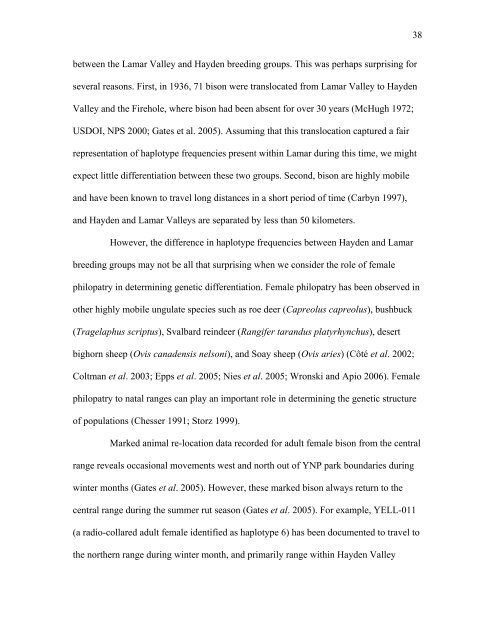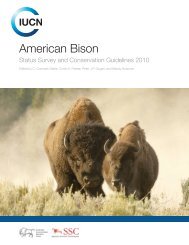Declaration Dr. Thomas H. Pringle - Buffalo Field Campaign
Declaration Dr. Thomas H. Pringle - Buffalo Field Campaign
Declaration Dr. Thomas H. Pringle - Buffalo Field Campaign
You also want an ePaper? Increase the reach of your titles
YUMPU automatically turns print PDFs into web optimized ePapers that Google loves.
etween the Lamar Valley and Hayden breeding groups. This was perhaps surprising for<br />
several reasons. First, in 1936, 71 bison were translocated from Lamar Valley to Hayden<br />
Valley and the Firehole, where bison had been absent for over 30 years (McHugh 1972;<br />
USDOI, NPS 2000; Gates et al. 2005). Assuming that this translocation captured a fair<br />
representation of haplotype frequencies present within Lamar during this time, we might<br />
expect little differentiation between these two groups. Second, bison are highly mobile<br />
and have been known to travel long distances in a short period of time (Carbyn 1997),<br />
and Hayden and Lamar Valleys are separated by less than 50 kilometers.<br />
However, the difference in haplotype frequencies between Hayden and Lamar<br />
breeding groups may not be all that surprising when we consider the role of female<br />
philopatry in determining genetic differentiation. Female philopatry has been observed in<br />
other highly mobile ungulate species such as roe deer (Capreolus capreolus), bushbuck<br />
(Tragelaphus scriptus), Svalbard reindeer (Rangifer tarandus platyrhynchus), desert<br />
bighorn sheep (Ovis canadensis nelsoni), and Soay sheep (Ovis aries) (Côté et al. 2002;<br />
Coltman et al. 2003; Epps et al. 2005; Nies et al. 2005; Wronski and Apio 2006). Female<br />
philopatry to natal ranges can play an important role in determining the genetic structure<br />
of populations (Chesser 1991; Storz 1999).<br />
Marked animal re-location data recorded for adult female bison from the central<br />
range reveals occasional movements west and north out of YNP park boundaries during<br />
winter months (Gates et al. 2005). However, these marked bison always return to the<br />
central range during the summer rut season (Gates et al. 2005). For example, YELL-011<br />
(a radio-collared adult female identified as haplotype 6) has been documented to travel to<br />
the northern range during winter month, and primarily range within Hayden Valley<br />
38










